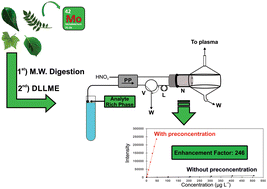Vortex-assisted dispersive liquid–liquid microextraction for the determination of molybdenum in plants by inductively coupled plasma optical emission spectrometry†
Abstract
A new procedure for determining trace concentrations of Mo in plants combining dispersive liquid–liquid microextraction and inductively coupled plasma optical emission spectrometry is proposed here. An automated discrete sample introduction system using a Flow Blurring® multiple nebulizer (FBMN) and a solenoid valve were used to insert an organic rich phase into the plasma. The experimental conditions for the microextraction procedure were: 0.5% m v−1 of 8-hydroxyquinoline, pH 3.6 and 50 μL of 1-undecanol as the extractant. A limit of detection of the instrument of 0.20 μg L−1, a limit of detection of the procedure of 17 μg kg−1 and an enhancement factor of 246 were obtained employing the developed procedure. Three certified reference materials were used to check the accuracy and no significant differences were found at the 95% confidence level between certified and determined values. The developed procedure was also successfully applied to the determination of Mo in three different varieties of sugar cane leaves samples.


 Please wait while we load your content...
Please wait while we load your content...